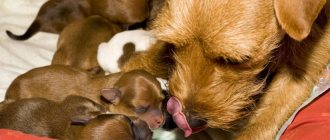When getting a dog, the owner must understand that this is a living creature that has a certain set of natural needs. Its wild ancestors move a lot in nature, run from place to place, and have a wide habitat. A domesticated animal retains its urge to move. He cannot be turned into an apartment recluse.
A list of rules and tips that will help if the dog does not want to go home after a walk.
Some amateur dog breeders are guided only by their preferences, without taking into account the need to create acceptable living conditions for their furry companion. It is in such cases that problems arise. The dog begins to shit indoors, chew furniture, barks and howls, irritating neighbors, behaves aggressively, and does not want to follow commands.
A closed space is not good for anyone. Inmates in prison stage protests if they are denied a walk. Your dog can do the same thing using means that are understandable to him. Restricting his freedom leads to a stressful state, which affects the character and health of the pet.
When preparing to get a dog, remember: you cannot lock it within four walls. You will have to spend a lot of time with her outside (which is good for your health too). And if your four-legged friend protests, not wanting to go back to the apartment, you only have yourself to blame. This means that you make mistakes in terms of training, education, but above all, you spend little time with your ward in the fresh air.
Attempts to deceive the dog.
Don't be cunning and work with the animal honestly. Learn to negotiate and find compromises. Do not bring a pet home by deception. Many dogs respond to their owners' names if they have been trained to do so, and many owners love to take advantage of this. For example, a dog walker says to a dog, “Where is mom?”, which makes the dog want to go home, and as a result, there is no mother in the house. Dogs quickly see through deception and cunning, and begin to behave the same way towards their owner, reducing their trust and respect.
Psychological
Fear
Dogs can be afraid of walking for various reasons, for example:
- low socialization of the dog caused by too early separation from its mother or life in a shelter: a puppy, and sometimes an adult dog, is afraid of the outside world and hides behind its owner at the first opportunity;
- stress during one of the previous walks: the dog was scared and does not want to repeat the negative experience (a car honked loudly, there was a clap of thunder, fireworks flashed brightly, there was a conflict with another dog - there may be plenty of reasons);
- change of place of residence - even moving out of town can be the reason for the dog’s reluctance to leave the house and go out to where everything is so unfamiliar, and there is nothing to say about changing the place of walks from a quiet park in a residential area to a busy boulevard in the city center.
There is no need to scold or feel sorry for a frightened dog, especially if we are talking about a puppy. A calm, friendly attitude and encouragement at every part of the path traveled in the form of praise or treats will help the pet regain self-confidence and calmly leave the house. If your attempts are unsuccessful, seek advice from a competent animal psychologist.
Mirroring
You can often hear from owners that the dog doesn’t like to walk in the rain. They've already bought her clothes and shoes, and wash her paws after every walk, but she still doesn't really like walking in the rain. Of course, not all dogs love high humidity, but the owner should ask himself a question: does he really like walking his pet in inclement weather?
It is quite possible that during such a walk the owner is either in too much of a hurry to cover the route faster, or does not go further than the yard and is counting the minutes until the end of the walk. In such conditions, the pet is unlikely to enjoy being outside, and if a similar scenario is repeated every time you leave the house in cloudy weather, then it is not surprising that sooner or later the dog will refuse to walk in the rain.
Boredom
Excessive predictability can play a cruel joke on the owner of an inquisitive dog, when walks in the same park along the same route become no longer enjoyable for the pet. If your dog looks like he's serving his duty on a walk, try changing the route or trying new types of activity (training on the playground or learning commands, for example), and then perhaps your stay-at-home pet of yesterday will turn into an ardent supporter of walks in the fresh air.
Physical punishment.
When a dog is regularly beaten, the dog begins to tighten itself more and more and withdraw into itself. What should an animal do if its owner causes pain and discomfort? That's right, avoid the offender. The pet experiences stress when you punish it, and at this moment it does not think about its behavior. In addition, some dogs may become aggressive towards their owner in order to protect themselves and mark boundaries. There is no need to spoil your relationship with your pet, because punishment will always find an alternative way to solve the problem. It’s better to show and explain to the dog, with the help of positive emotions and treats, how to behave in this situation.
Prevention
Hip dysplasia can be prevented by keeping it under control and making sure your dog has a healthy diet and exercise routine. Arthritis, intervertebral disc disease, degenerative myelopathy and fibrocartilaginous embolic myelopathy cannot be prevented, but only treated. Regular health checks are recommended for all dogs of all ages, allowing illnesses and conditions that might not otherwise be diagnosed until later stages to be identified and treated.
Attempts to catch up and catch the pet.
An important training rule: never run after your dog. Pets are much faster and more agile than us. If you catch up with the dog, it will begin to run away from you even more intensely, displaying this behavior on every walk. Many animals like this “game” and simply manipulate their owner. It’s better to start running away and hiding from the dog so that it learns to come to you. If you approach, you do not need to immediately catch the animal and attach it to a leash. Praise your dog for good behavior with treats, play, and kind words.
We hope that our methods will help you combat unwanted behavior in your pet. We wish you and your four-legged good luck!
The dog doesn't want to go home after a walk. What to do?
Some potential dog owners are guided only by their desires, which means they act selfishly. However, biology is a merciless and vindictive lady. She takes revenge on such owners through the hostile actions of the dog: destruction of the apartment, urination and defecation in the house, howling and barking (complaints from neighbors!), dog disobedience, and even aggressiveness.
Most domestic dogs, i.e. dogs living in apartments and houses, are under constant stress. Judge for yourself: a domestic/apartment dog lives in conditions of spatial limitation, that is, in a confined space. And who exists in conditions of limited freedom? Right. Prisoners. Thus, the pet/apartment dog is sentenced to life imprisonment. What I mean is that restriction of freedom in all living beings causes a state of stress of varying severity.
What if you walk the dog?
If you walk your dog a lot, often and correctly, this will certainly help. However, a survey of 439 dog owners of 76 breeds showed that the duration of a morning walk for 53% of owners ranged from 15 to 30 minutes. But during this time it is impossible to satisfy the dog’s existing needs: the need for physical activity, the need for new information and the need for additional stimulation. This is actually true because research has shown that the total incidence of unwanted dog behavior correlates with the length of the walk: the longer the morning walk, the less unwanted behavior is observed.
If we talk about the need for physical activity, then dogs need to be walked until they get tired. Then they will be happy. No time? Why did you get a dog then?
In the evening, owners walk their dogs longer. This is true. But they walk longer not because the dogs need it, but they walk longer in order to rest after a working day and relax before bed. Dogs do not need to walk longer in the evening. At night they sleep.
Hurry up, choose a box and find out what gift awaits you
Discount on pet insurance
Promo code copied to clipboard
A walk is not only physical activity, it is the time when the dog is exposed to millions of different irritants and stimuli that are so necessary for the optimal functioning of its nervous system. Let's remember that for thousands of years the dog's central nervous system existed and developed under the influence of a huge number of different stimuli and irritants. And this has become not only the norm, but also a necessity.
When you go to work and leave your dog alone in a cramped, poor, and monotonous apartment, he experiences sensory deprivation. And this doesn’t make her any happier. By the way, under conditions of sensory deprivation, people also experience stress, become depressed or go crazy.
And when you leave the dog alone, you leave him alone! And all the books say that a dog is a highly socialized creature. Left alone, she finds herself in a situation of social deprivation and, accordingly, experiences a state of social stress and boredom.
Thus, returning home for some dogs means returning to solitary confinement, a situation of sensory and social deprivation and confinement. Now you understand why some dogs don't want to go home.
What to do?
Organize the maintenance of the dog in such a way as to satisfy the deficits that it experiences. Get up earlier and walk the dog longer and more actively. Get intelligent dog toys at home.
If you can’t do this yourself, hire a person to come or on your way to work, take your dog to the nearest dog hotel, where they can work with the dog, satisfying all its canine needs.
Walk your dog on a leash and teach unquestioning obedience. This, of course, will not make the dog happier, but it will relieve the problem of resistance.
Health status
The dog therapist claims that dogs, like people, can have pain in their joints and muscles. If there was heavy physical activity the day before, then give your pet the opportunity to recover and do not force him outside.
But there may be more serious health problems. If an always active and cheerful dog suddenly becomes lethargic, apathetic, passive, then it makes sense to get examined by a veterinarian. It is necessary to exclude any health problems.
Particularly dangerous cases (do not delay a trip to the veterinarian)
Poisoning
Food or chemical poisoning is very dangerous. Severe poisoning leads to dehydration. In case of poisoning, you should immediately go to a veterinary clinic. The doctor will perform a gastric lavage and give special medications.
Gastrointestinal problems
All kinds of gastrointestinal diseases from gastritis to intestinal obstruction can lead to lethargy in a dog. Also, in this condition, the dog may experience diarrhea and vomiting. Usually animals refuse to eat or drink.
Worms
If left untreated, worms can have a serious effect on your dog's body. The first symptoms are itching in the anus, disturbances in the gastrointestinal tract, blood in the stool, and gases.
Virus
Viral infections are quite diverse. Without taking tests, it is very difficult to determine the origin of the virus. It could be canine flu or rabies.
Oncology
Sudden weight loss, decreased activity, refusal to eat, frequent mood changes are the first symptoms of oncology. At the beginning, the disease is very difficult to identify. Usually the diagnosis is made when the disease is in its final stages. Depending on the form, there are several treatment methods that the veterinarian will select.
Tick bite
During the summer, it is necessary to protect the dog from parasites. Buy drops or a collar specifically designed for flea and tick protection. After a walk in the park, try to examine your pet's body for a parasite bite. Typically the skin at the site of the bite is red and swollen. If you find a tick, do not try to remove it yourself; it is better to take your dog to the veterinarian.
Getting used to the collar
The process of “mastering” a leash should begin with preparation, which in this case is getting used to the collar. This is very important, because for the puppy at first the very sensation of the collar will be quite a big irritant, not to mention the leash pulling and getting tangled in its paws.
Experienced dog breeders recommend gradually accustoming small puppies to a collar. To begin with, the simplest synthetic model will be enough, and a more “serious” collar can be purchased later.
So, the key rules are:
- Wear the collar briefly in a quiet environment without other stimuli.
- When trying to remove it, you need to distract the puppy. This can be done with a game or a treat.
- It is worth being persistent - you cannot remove the collar while the puppy is trying to do it himself, otherwise he will quickly understand that this is a good way to “win”. As soon as the pet calms down and, albeit with dissatisfaction, accepts the inconvenience, you should encourage him and then remove the collar.
Once your four-legged friend gets used to wearing a collar, you can move on to attaching a leash.











